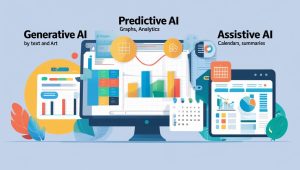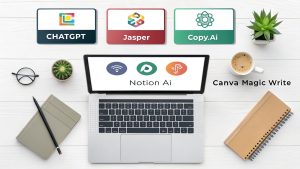Welcome to the world of Artificial Intelligence, where machines don’t just compute, they learn, adapt, and even create. If the term AI has been buzzing in your ears lately, you’re not alone. From headlines about ChatGPT and self-driving cars to Instagram filters and Netflix recommendations, AI is everywhere, and it’s not just for computer scientists anymore.
You might be wondering:
-
What exactly is AI?
-
Why is everyone suddenly obsessed with it?
-
And most importantly: Can I use it without being a tech genius?
If you’ve asked yourself any of those questions, you’re in the right place. This guide is designed for complete beginners, no coding, no jargon, just clear explanations and practical tools you can start using today. Whether you want to boost productivity, make money online, or simply understand what’s going on, this is your easy path into the AI universe.
What is AI? (And why should you care?)
A simple definition of AI
Let’s strip away the mystery.
Artificial Intelligence (AI) is simply a set of computer systems designed to perform tasks that usually require human intelligence. These tasks include things like understanding language, recognizing patterns, solving problems, and even making decisions.
In plain English? AI helps machines think, learn, and act, based on data. But here’s the thing: AI doesn’t mean one thing. It’s a spectrum.
-
At the basic level, AI can be something as simple as email filters detecting spam.
-
At more advanced levels, it includes technologies like self-driving cars or AI art generators like Midjourney or DALL·E.
And the best part? You don’t have to build AI, you can use it, often for free, to make your life easier.
AI vs Machine learning vs Deep learning, What’s the difference?
These three terms are often used interchangeably, but they’re not quite the same:
-
Artificial Intelligence is the big umbrella. It refers to the general concept of machines doing smart stuff.
-
Machine Learning (ML) is a branch of AI. It means machines can learn from data without being explicitly programmed.
-
Deep Learning is a subfield of ML. It uses complex algorithms called neural networks to mimic the human brain, this is how tools like ChatGPT and voice recognition systems work.
Think of it like this:
AI = The whole pizza
ML = A slice with cheese and tomato
Deep Learning = The spicy pepperoni topping on that slice
Why should you care about AI (Even if you’re not into tech)?
Because AI is already in your life, whether you know it or not. Here are some examples:
-
Google Maps suggesting faster routes
-
Netflix predicting what you want to watch next
-
Amazon recommending products based on your search habits
-
Siri, Alexa, Google Assistant understanding your voice
-
Gmail predicting your sentence as you type
AI is quietly helping you save time, make decisions, and improve your experience across digital platforms. So instead of resisting it, why not learn how to use it to your advantage?
The main types of AI you’ll encounter
AI isn’t one-size-fits-all. There are different types, and each is useful in different situations. As a beginner, understanding these will help you choose the right tools and avoid getting overwhelmed. Let’s break them down.

1. Generative AI, the creative one
This is the flashy stuff everyone’s talking about. Generative AI can create things: text, images, music, and even video.
Examples:
-
ChatGPT – writes content, answers questions, helps brainstorm ideas.
-
DALL·E / Midjourney – turns your text into stunning images.
-
Synthesia – creates videos with AI avatars and voiceovers.
If you’re a blogger, student, marketer, or entrepreneur, this is the go-to AI type to boost creativity and productivity.
2. Predictive AI, the smart forecaster
Predictive AI does exactly what it sounds like, it analyzes data and predicts outcomes.
Examples:
-
Spotify suggesting your next song
-
E-commerce sites recommending items
-
Businesses forecasting sales or customer behavior
It’s like a crystal ball powered by math and machine learning.
If you run a business or create content, predictive AI can help you make data-driven decisions.
3. Assistive AI, your silent productivity partner
This is the AI that makes your life easier without being flashy.
It’s embedded in tools that help you:
-
Schedule meetings
-
Sort emails
-
Transcribe voice notes
-
Summarize long documents
Tools like Notion AI, Zapier, and Otter.ai fall into this category.
While you go about your day, assistive AI quietly handles the tasks you’d rather not do.
How to start using AI today (No tech skills needed)
One of the most common misconceptions about AI is that you need to be a coder, data scientist, or tech wizard to use it. That couldn’t be further from the truth.
Today’s AI tools are built for non-technical users. They come with intuitive interfaces, templates, drag-and-drop builders, and simple dashboards. If you know how to use a web browser and write an email, you’re already qualified to start.

Pick a use case that solves a real need
Before diving into a bunch of tools, ask yourself: What do I want AI to help me with?
Here are a few beginner-friendly use cases that deliver real value:
-
Writing: Blog posts, emails, social media captions, product descriptions.
-
Scheduling: Automating your calendar, setting reminders, organizing meetings.
-
Design: Generating visuals, thumbnails, logos, and presentations.
-
Marketing: Generating ad copy, social media strategies, or product ideas.
-
Data: Summarizing analytics, creating reports, or cleaning spreadsheets.
-
Productivity: Organizing notes, automating repetitive tasks, managing tasks.
By narrowing your focus to one or two areas, you’ll get faster results, and avoid overwhelm.
Best Beginner-Friendly AI tools you can use today
Let’s look at a few widely used tools that require zero technical skills and offer great results out of the box.
1. Jasper (formerly Jarvis)
An excellent tool for content creation. You can write blog posts, ads, emails, or product descriptions in minutes. Jasper uses GPT-based AI with fine-tuned templates for marketers and creators.
2. Copy.ai
Perfect for beginners looking for a fast and easy way to generate copy. It includes templates for everything from startup pitches to Instagram captions.
3. Notion AI
Notion is a powerful note-taking and productivity tool, and its AI assistant can summarize notes, generate ideas, or help write emails. It’s great for organizing your digital life.
4. Zapier
This tool helps you automate tasks between apps without needing to code. For example, you can set up a workflow that sends new Gmail attachments straight to Dropbox, or posts new blog entries to your social media channels.
5. Canva Magic Write
Integrated into Canva Docs, this tool lets you generate written content directly within your design projects. Ideal for creating presentations, flyers, and branded documents with AI-enhanced speed.
These tools typically come with free trials or freemium plans, so you can test them without spending a dime.
How to test tools effectively as a beginner
Don’t try everything at once. Here’s a simple 3-step framework to make the most of each tool you try:
-
Choose one real task you’re working on (e.g., writing a blog post).
-
Use the AI tool to complete it, don’t worry if it’s not perfect. The goal is to understand how the tool works and where it shines.
-
Evaluate the output: Was it useful? How much time did it save you? Would you use it again?
With just 1 or 2 hours of exploration, you’ll start to build confidence in what AI can do for you personally.
Learn AI easily (No coding required)
Once you start using AI tools, you might feel curious to understand the bigger picture. Luckily, you don’t need a computer science degree to get fluent in AI. There are hundreds of resources made for non-developers. Here’s how you can get started with learning the foundations of AI.
Top free or affordable AI courses for beginners
The key is to choose beginner-level courses focused on practical applications.
1. Coursera, AI for everyone by Andrew Ng
One of the most famous introductory courses. No math, no code, just plain English explanations of what AI is, how it works, and how it affects business and society.
2. LinkedIn learning, AI foundations
Covers key concepts in under 2 hours. Includes video lectures and quizzes.
3. Skillshare, AI tools for creatives and entrepreneurs
Focused on using AI for design, marketing, and content creation.
4. YouTube channels (free and diverse)
Look for creators who focus on AI tutorials and use cases. Channels like “Matt Wolfe”, “AI Explained”, or “Future Tools” provide tutorials and reviews for trending tools.
5. Google’s learn AI with Google
Offers a set of self-paced lessons on how machine learning works, along with visual explanations. Great for those who like structured learning.
Books and guides for Non-Technical learners
Prefer reading at your own pace? Here are a few highly recommended beginner-friendly books:
-
“AI Superpowers” by Kai-Fu Lee – Great overview of AI’s global impact.
-
“The Age of AI” by Henry Kissinger, Eric Schmidt, and Daniel Huttenlocher – Offers insight into how AI will shape the future of work and society.
-
“You Look Like a Thing and I Love You” by Janelle Shane – A fun and approachable book explaining AI quirks through real examples.
Many of these are available as audiobooks, too.
Set a realistic AI learning path
Here’s a suggested roadmap you can follow as a complete beginner:
-
Week 1 – Try one beginner-friendly AI tool (e.g., Jasper or Notion AI).
-
Week 2 – Watch a course or 3–4 YouTube videos to understand the concepts.
-
Week 3 – Read one guide or book chapter on AI fundamentals.
-
Week 4 – Try building a mini project using AI (write an article, automate a task, etc.)
Just 30 minutes a day is enough to build valuable knowledge without pressure.
Can you make money with AI as a beginner?
Yes, you absolutely can. The idea that you need to be a data scientist or developer to earn money with AI is outdated. In fact, many beginners are already using AI to build side hustles, freelance services, or passive income streams. Let’s explore how you can do the same.

Real-World income streams powered by AI
Here are a few common ways people are already generating income using beginner-friendly AI tools:
1. Freelance writing and copywriting
With tools like Jasper, Copy.ai, and ChatGPT, you can create content much faster. AI helps you brainstorm, draft, and polish articles, email campaigns, product descriptions, and more. Platforms like Fiverr and Upwork are filled with beginners offering AI-assisted writing services.
2. Selling digital products
Use AI to generate content for e-books, online courses, printables, or templates. Then sell them on platforms like Gumroad, Etsy, or your own website. Tools like Canva + AI text generation make it easy to produce high-quality assets quickly.
3. Content creation for Social Media
Create short-form content for TikTok, Instagram, or YouTube using AI-generated scripts, images, and video voiceovers. You don’t need to show your face or be an influencer, just repurpose AI-generated ideas and trends.
4. Automating services for businesses
Many small businesses don’t even know AI tools exist. You can offer services like automating email responses, building chatbots, or managing content calendars using AI tools like Zapier or Notion AI. All without coding.
5. Niche blogging with AI help
Launch a blog with AI support to generate articles quickly. Monetize through affiliate marketing, display ads, or digital product sales. Focus on low-competition keywords and build content fast with help from AI writers.
Recommended tools to monetize your AI use
If you’re ready to experiment, here are tools to try:
-
ChatGPT or Jasper for writing content and emails
-
Canva Magic Write for marketing visuals and lead magnets
-
Synthesia or Pictory for video creation and faceless YouTube content
-
Tidio or ManyChat for AI-powered chatbots
-
Frase.io or SurferSEO for content optimization and SEO monetization
All these tools are user-friendly and offer free trials or low-cost plans to get started.
Set your first AI revenue goal
Here’s a quick roadmap:
-
Pick one platform (Upwork, Etsy, or your blog).
-
Choose a monetizable task you can do with AI (writing, video, digital product).
-
Set a small goal: for example, earn your first $100.
-
Use AI to save time and improve quality, your speed will be your competitive advantage.
It’s not about “getting rich quick.” It’s about using AI to amplify your efforts and enter the market faster.
Is AI safe? What you need to know
As exciting as AI is, it also raises important concerns, especially for beginners who might not yet understand how these tools work under the hood.
Let’s address them clearly and honestly.
The risks of AI: What you should be aware of
AI tools are built on massive datasets, which can sometimes contain bias, outdated information, or incorrect assumptions. That means AI outputs can be:
-
Biased: Reflecting stereotypes or unfair assumptions.
-
Inaccurate: Especially in areas like health, finance, or legal advice.
-
Manipulative: Some AI models can be used to spread misinformation or create deepfakes.
This doesn’t mean AI is bad, it just means you should always double-check AI-generated content, especially when accuracy matters.
How to use AI responsibly as a beginner
Here are 5 practical tips:
-
Don’t treat AI as a source of truth. Use it as a tool to assist, not replace, your judgment.
-
Edit everything. AI is great at generating drafts, but human editing is still essential.
-
Avoid confidential or personal data. Never feed private information into AI tools unless they are fully secure and local.
-
Stay transparent. If you’re using AI in your business or content, let people know. It builds trust.
-
Keep learning. AI evolves fast. Staying informed will help you use it ethically and effectively.
The future of AI and why it needs you
AI will only get smarter, but that means humans need to be smarter too about how we use it. As a beginner, you’re already part of the conversation by learning and participating early. And as AI grows, people who know how to use it ethically and creatively will be in high demand.
Take the first step into the world of AI
Artificial Intelligence isn’t some mysterious force anymore, it’s a practical, powerful, and accessible tool that can help you write faster, think smarter, save time, and even make money.
You don’t need to learn code, become an engineer, or buy expensive software. What you need is curiosity, a clear purpose, and the right beginner tools.
So, what’s stopping you?




Pingback: How To Earn Income Using AI Tools For Beginners – Streamlinegoals.com